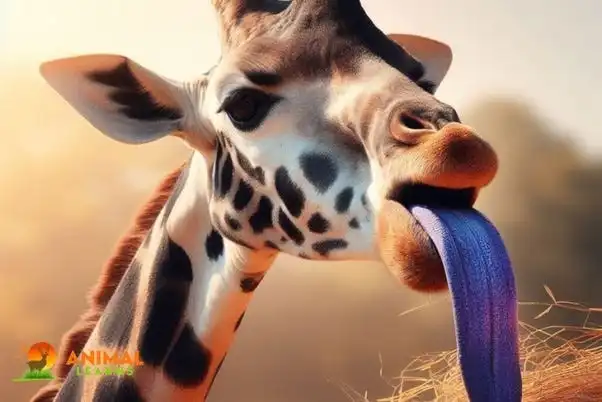Giraffes are fascinating animals that have many unique features. They are the tallest living land animals, with an average height of about 5.5 meters (18 feet). They have long necks that can measure up to 2.4 meters (8 feet), which allow them to reach the leaves of tall trees. They also have distinctive patterns of spots on their fur, which help them camouflage in their savanna habitat.
But one of the most remarkable features of giraffes is their tongue. The giraffe’s tongue is long, flexible, and has a surprising color. In this article, we will explore the giraffe’s tongue in detail and answer the question: what color is a giraffe’s tongue?
The Giraffe’s Tongue
The giraffe’s tongue is an impressive organ that can measure up to 45 centimeters (18 inches) in length. It is also prehensile, which means that it can grasp and manipulate objects. The giraffe uses its tongue to pluck leaves from branches, strip bark from trees, and clean its nose and ears.
The color of the giraffe’s tongue is not uniform. The front part of the tongue, which is exposed to the air, is dark in color, ranging from black to blue to purple. The back part of the tongue, which is hidden inside the mouth, is pink or light brown.
The Color of the Giraffe’s Tongue
Why is the giraffe’s tongue dark in color? The most widely accepted explanation is that the dark coloration helps protect the tongue from sunburn. Giraffes spend most of their day feeding on leaves, which means that their tongues are exposed to the sun for long periods of time. The sun’s ultraviolet rays can damage the skin and cause inflammation, pain, and blistering.
To prevent sunburn, the giraffe’s tongue has a high concentration of melanin, a pigment that gives color to the skin and hair. Melanin absorbs the ultraviolet rays and acts as a natural sunscreen. The more melanin the tongue has, the darker it is. The back part of the tongue, which is not exposed to the sun, has less melanin and is lighter in color.
Why Do Giraffes Have Purple Tongues?
The answer lies in melanin, the same pigment responsible for human skin and hair color. The dark portion of the giraffe’s tongue contains abundant melanin. But what purpose does it serve? Let’s explore:
- Sun Protection: Giraffes are voracious eaters, spending up to 12 hours a day munching on leaves from tall trees like the acacia. As they extend their tongues repeatedly, they face prolonged sun exposure. The melanin-rich front half acts as a natural sunscreen, shielding the sensitive tissue from harmful UV rays. After all, who wants to dine with a sunburned tongue?
- Thorny Trees: The giraffe’s favorite menu item includes leaves from the Senegalia and Vachellia (formerly Acacia) trees. These trees are armed with sharp thorns. Fortunately, the prehensile nature of the tongue allows giraffes to deftly maneuver it, avoiding painful pricks. Additionally, the thickened papillae (those rough bumps containing taste buds) provide extra protection.
- High Melanin Content: The dark portion of a giraffe’s tongue is high in melanin, which is a pigment that helps protect against sun exposure.
Effect of Sun’s Exposure Affect Giraffe’s Tongue
The giraffe’s tongue is not the only part of its body that is affected by sun exposure. The giraffe’s lips, mouth, and eyes are also vulnerable to sunburn. To protect these areas, the giraffe has several adaptations. For example, the giraffe’s lips are thick and tough, which help them withstand the thorns and spines of the plants they eat. The giraffe’s mouth is lined with a thick layer of saliva, which acts as a lubricant and a cooling agent. The giraffe’s eyes are protected by long eyelashes and a nictitating membrane, which is a transparent eyelid that can cover the eye.
The giraffe’s feeding habits also influence the amount of sun exposure it receives. Giraffes are browsers, which means that they eat leaves from trees and shrubs. They prefer to feed on acacia trees, which have high nutritional value and water content. Acacia trees also have thorns, which deter most herbivores from eating them. However, giraffes have developed a way to avoid the thorns. They use their tongue to wrap around the leaves and pull them off the branch, leaving the thorns behind. This way, they can eat up to 34 kilograms (75 pounds) of leaves per day.
Other Functions of the Giraffe’s Tongue
The giraffe’s tongue is not only used for eating. It also serves other functions that help the giraffe survive in its environment. For instance, the giraffe’s tongue can help it communicate with other giraffes. Giraffes are social animals that live in loose groups called herds. They use different sounds and gestures to communicate with each other, such as snorts, grunts, moans, and whistles. They also use their tongue to lick each other’s faces, which is a way of greeting and bonding.
Another function of the giraffe’s tongue is to help it sense its surroundings. The giraffe’s tongue has many taste buds, which allow it to detect the flavor and quality of the food it eats. The giraffe’s tongue also has many nerve endings, which enable it to feel the texture and temperature of the objects it touches. The giraffe can use its tongue to explore its environment and find the best sources of food and water.
Conclusion
The giraffe’s tongue is a remarkable feature that has many unique characteristics. It is long, flexible, prehensile, and dark in color. The color of the giraffe’s tongue is due to the presence of melanin, which protects it from sunburn. The giraffe’s tongue also helps it feed on leaves, communicate with other giraffes, and sense its environment. The giraffe’s tongue is a testament to the amazing adaptations that giraffes have evolved to survive in their habitat.

